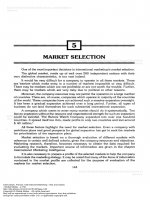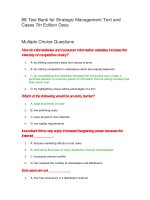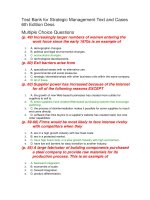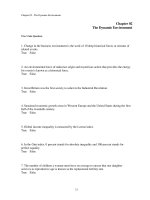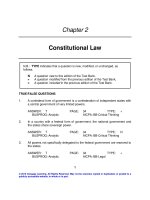Marketing research text and cases
Bạn đang xem bản rút gọn của tài liệu. Xem và tải ngay bản đầy đủ của tài liệu tại đây (4.27 MB, 411 trang )
Bruce Wrenn, PhD
Robert Stevens, PhD
David Loudon, PhD
Marketing Research
Text and Cases
Pre-publication
REVIEW
arketing Research: Text and Cases
“M
is a basic, clear, and thorough
guide to the process and science of con-
As an instructor of a marketing research course, I believe this text assists
the reader by presenting each of the
three different types of research design (exploratory, descriptive, and
causal) and then offering methods
used in that particular design. The
chapter on primary research is especially helpful to the novice researcher.
I believe this book would be a very
useful text for an undergraduate course
in research or a helpful addition to an
MBA course in marketing management.”
ducting research. This text is especially
helpful to those who do not have a
mathematical background or those who
have been away from a statistics course
for a few years. Its straightforward discussion presents the concepts of research without clouding the issue with
scenarios simultaneously. This allows the
reader to truly understand the concept
and then make an application with the Phylis M. Mansfield, PhD
case studies provided at the end of the Assistant Professor of Marketing,
Penn State University, Erie
book.
NOTES FOR PROFESSIONAL LIBRARIANS
AND LIBRARY USERS
This is an original book title published by Best Business Books®, an imprint of The Haworth Press, Inc. Unless otherwise noted in specific chapters with attribution, materials in this book have not been previously published elsewhere in any format or language.
CONSERVATION AND PRESERVATION NOTES
All books published by The Haworth Press, Inc. and its imprints are
printed on certified pH neutral, acid free book grade paper. This paper
meets the minimum requirements of American National Standard for Information Sciences-Permanence of Paper for Printed Material, ANSI
Z39.48-1984.
Marketing Research
Text and Cases
BEST BUSINESS BOOKS
Robert E. Stevens, PhD
David L. Loudon, PhD
Editors in Chief
Strategic Planning for Collegiate Athletics by Deborah A. Yow, R. Henry
Migliore, William W. Bowden, Robert E. Stevens, and David L.
Loudon
Church Wake-Up Call: A Ministries Management Approach That Is
Purpose-Oriented and Inter-Generational in Outreach by William
Benke and Le Etta N. Benke
Organizational Behavior by Jeff O. Harris and Sandra J. Hartman
Marketing Research: Text and Cases by Bruce Wrenn, Robert Stevens,
and David Loudon
Doing Business in Mexico: A Practical Guide by Gus Gordon and
Thurmon Williams
Marketing Research
Text and Cases
Bruce Wrenn, PhD
Robert Stevens, PhD
David Loudon, PhD
Best Business Books®
An Imprint of The Haworth Press, Inc.
New York • London • Oxford
Published by
Best Business Books®, an imprint of The Haworth Press, Inc., 10 Alice Street, Binghamton, NY
13904-1580.
© 2002 by Bruce Wrenn/Robert Stevens/David Loudon. All rights reserved. No part of this work
may be reproduced or utilized in any form or by any means, electronic or mechanical, including
photocopying, microfilm, and recording, or by any information storage and retrieval system,
without permission in writing from the publisher. Printed in the United States of America.
In all case studies names, selected data, and corporate identities have been disguised.
Cover design by Anastasia Litwak.
Library of Congress Cataloging-in-Publication Data
Wrenn, W. Bruce.
Marketing research : text and cases / W. Bruce Wrenn, Robert E. Stevens, David L. Loudon.
p. cm.
Includes bibliographical references and index.
ISBN 0-7890-0940-4 (alk. paper)—ISBN 0-7890-1590-0 (alk. paper)
1. Marketing research. 2. Marketing research—Case studies. I. Loudon, David L. II. Stevens,
Robert E., 1942- III. Title.
HF5415.2. W74 2002
658.8’3—dc21
2001035947
CONTENTS
Acknowledgments
xi
Chapter 1. Introduction to Marketing Research
1
The Marketing-Decision Environment
Marketing Research
Marketing Research and Decision Making
Strategic versus Tactical Information Needs
The Nature of Marketing Research
Steps in a Marketing Research Project
Marketing Information Systems
Summary
Chapter 2. Research Designs for Management Decision
Making
Types of Research Designs
Exploratory Research
Descriptive Research
Causal Research
Experimentation
Exploratory, Descriptive, or Causal Observation
Dangers of Defining Design by Technique
Summary
Chapter 3. Secondary Data
1
2
3
6
6
12
24
25
27
27
30
37
44
46
60
61
62
63
Uses of Secondary Data
Advantages of Secondary Data
Disadvantages of Secondary Data
Secondary Data Sources
Summary
63
64
65
65
78
Chapter 4. Primary Data Collection
79
Sources of Primary Data
Types of Primary Data
80
80
Methods of Collecting Primary Data
Communication Methods
Survey Methods
Observation Methods
Summary
Chapter 5. Measurement
84
86
96
106
107
109
Introduction
The Process of Measurement
What Is to Be Measured?
Who Is to Be Measured?
How to Measure What Needs to Be Measured
Assessing Reliability and Validity of Our Measures
Measuring Psychological Variables
Summary
109
111
117
118
119
121
127
138
Chapter 6. Designing the Data-Gathering Instrument
139
Goals of a Questionnaire
Classification of Questions
Designing a Questionnaire
Summary
Chapter 7. Sampling Methods and Sample Size
What Is Sampling?
Why Sampling?
Sampling Error, Sample Bias, and Nonsampling Error
Sampling Decision Model
Probability Sampling
Nonprobability Samples
Probability versus Nonprobability Sampling
Statistical Sampling Concepts
What Is a “Significant” Statistically Significant Difference?
Summary
Chapter 8. Fielding the Data-Gathering Instrument
Planning
Guidelines for Interviewers
141
143
147
154
157
157
158
159
160
163
165
167
168
176
177
179
179
180
Types of Interviews
The Interviewing Relationship
The Interviewing Situation
The Actual Interview
Fielding a Research Project
Errors in Data Collection
Types of Nonsampling Errors
Summary
Chapter 9. Introduction to Data Analysis
From Data to Decisions
Data Summary Methods
Cross-Tabulation
Summary
Chapter 10. Advanced Data Analysis
Marketing Research and Statistical Analysis
Hypothesis Testing
Measures of Association
Summary
181
183
184
186
189
195
196
200
201
202
206
212
221
223
223
224
233
241
Chapter 11. The Research Report
243
Introduction
Report Format
Guidelines for the Written Report
Oral Reports
Summary
243
244
269
276
278
CASES
Contributors
Case 1. Lone Pine Kennel Club
Case 2. Select Hotels of North America
Case 3. River Pines School: A
Case 4. River Pines School: B
Case 5. Gary Branch, CPA
Case 6. Juan Carlos’ Mexican Restaurant
279
280
281
283
287
291
297
305
Case 7. Usedcars.com
Case 8. Welcome Home Church
Case 9. The Learning Source
Case 10. Madison County Country Club
Case 11. Plasco, Inc.
Case 12. St. John’s School
Case 13. The Webmasters
Case 14. House of Topiary
Case 15. Professional Home Inspection
Case 16. Europska Databanka
313
321
325
331
337
343
349
355
359
369
Notes
379
Index
385
ABOUT THE AUTHORS
Bruce Wrenn, PhD, is Associate Professor of Marketing in the Division of
Business and Economics at Indiana University South Bend. The author of
several books on marketing management, planning, research, and marketing for religious organizations, Dr. Wrenn has also written numerous articles on marketing strategy, research, and marketing techniques for nonprofit
and health care organizations. He spent several years with a major pharmaceutical company performing market analysis and planning and has served
as a consultant to a number of industries, religious denominations, and organizations in the food, high tech, and health care industries.
Robert Stevens, PhD, is Professor of Marketing in the Department of Management and Marketing at the University of Louisiana at Monroe. During
his distinguished career, Dr. Stevens has taught at the University of Arkansas, the University of Southern Mississippi, and Hong Kong Shue Yan College. His repertoire of courses has included marketing management, business research, statistics, marketing research, and strategic management. The
author and co-author of 20 books and well over 100 articles, he has published his research findings in a number of business journals and numerous
professional conference proceedings. He is co-editor of the Journal of Ministry Marketing & Management and Services Marketing Quarterly, and
serves on the editorial boards of four other professional journals. Dr.
Stevens has acted as a marketing consultant to local, regional, and national
organizations and is the owner of two small businesses.
David Loudon, PhD, is Professor of Marketing and Head, Department of
Management and Marketing in the College of Business Administration at
the University of Louisiana at Monroe. He has been a faculty member at
Louisiana State University, the University of Rhode Island, Hong Kong
Shue Yan College, and the North American Executive Program in Monterrey,
Mexico. He has taught a variety of courses but focuses on marketing management and consumer behavior. Dr. Loudon is the co-author of twelve
books and has conducted research in the United States, Europe, Asia, and
Latin America on such topics as consumer behavior, international marketing, services marketing, and marketing management. He has written over
100 papers, articles, and business cases, and his research findings have been
published in a number of journals and in the proceedings of numerous professional conferences. He is co-editor of Best Business Books, an imprint of
The Haworth Press, Inc., and co-editor of two journals: Services Marketing
Quarterly and Journal of Ministry Marketing & Management.
Acknowledgments
Many individuals contributed to the development of this book. We owe
special thanks to Cynthia Castillo, who typed the many drafts of cases and
to Orsolya Lunscsek, who helped with the development of the test bank—
both MBA students at the University of Louisiana at Monroe. Special
thanks also to Vicki Mikulak who typed drafts of the book.
Special thanks to the following contributors of cases and case teaching
notes: Dr. Henry S. Cole, Dr. Bruce C. Walker, Dr. Stanley G. Williamson,
Dr. Marlene M. Reed, Michael R. Luthy, and Dr. Edward L. Felton.
PowerPoint slides are available for this text and can be acquired by contacting Dr. Robert E. Stevens: University of Louisiana at Monroe, 700 University Dr., Monroe, LA 71209, telephone (318) 342-1201, or e-mail
Chapter 1
Introduction to Marketing Research
THE MARKETING-DECISION ENVIRONMENT
Marketing decisions in contemporary organizations are some of the most
important decisions made by managers. The decisions of what consumer
segments to serve with what products/services, at what prices, through
which channels, and with what type and amounts of promotion not only determine the marketing posture of a firm, but also affect decisions in other
areas as well. The decision to emphasize quality products, for example, affects decisions on procurement, production personnel, quality control, etc.
Many companies are discovering that the decisions involved in creating
and distributing goods and services for selected consumer segments have
such long-run implications for the organization that they are now being
viewed as strategic decisions necessitating input by top management. Some
marketing decisions, such as those relating to strategy, may involve commitments and directions that continue to guide efforts as long as they prove
successful. A belief that future success requires the organization to become
“market oriented”1 or “market sensitive” has increased the importance of
the intelligence function within organizations as they seek to make the right
responses to a marketplace. Right responses become increasingly important
as competition heats up in markets. Firms are discovering that they must be
market driven in order to make decisions that meet with market approval.
Developing an understanding of consumer needs, wants, perceptions,
etc., is a prerequisite to effective decision making. Consider the different results of marketing Pepsi AM in the United States and Chee-tos in China.
Pepsi AM was introduced without research, which would have revealed that
the name suggested it to be drunk only in the morning, thereby restricting
market size to specific-occasion usage. Frito-Lay did extensive research on
the market for snack foods in China before introducing Chee-tos there.
They learned that cheese was not a common item in the diet of Chinese, that
traditional Chee-tos flavors did not appeal to consumers there, but that some
flavors were appealing (savory American cream and zesty Japanese steak).
They also researched Chinese reaction to Chester Cheetah, the cartoon char-
acter on the bag, and the Chinese translation of “Chee-tos” (luckily corresponding to Chinese characters qu duo or “new surprise”). Pepsi AM was a
flop; Chee-tos were such a success that Frito-Lay could not keep store
shelves stocked.2
Marketing research is the specific marketing function relied upon to provide information for marketing decisions. However, it should be stressed at
the outset that merely doing marketing research does not guarantee that better
decisions will be made. The quality of each stage of a marketing research project will either contribute to better decision making or will make it an ever
elusive goal. If research results are correctly analyzed and imaginatively applied, studies have shown that increased profitability is often the outcome.3
MARKETING RESEARCH
The American Marketing Association defines marketing research as follows:
Marketing research is the function which links the consumer, customer, and public to the marketer through information—information
used to identify and define marketing opportunities and problems;
generate, refine, and evaluate marketing actions; monitor marketing
performance; and improve understanding of marketing as a process.
Marketing research specifies the information required to address
these issues; designs the method for collecting information; manages
and implements the data collection process; analyzes the results; and
communicates the findings and their implications.4
This rather lengthy definition suggests the connection between research and
decision making in business organizations.
Research, in a business context, is defined as an organized, formal inquiry
into an area to obtain information for use in decision making. When the adjective marketing is added to research, the context of the area of inquiry is defined. Marketing research, then, refers to procedures and techniques involved
in the design, data collection, analysis, and presentation of information used
in making marketing decisions. More succinctly, marketing research produces the information managers need to make marketing decisions.5
Although many of the procedures used to conduct marketing research
can also be used to conduct other types of research, marketing decisions require approaches that fit the decision-making environment to which they
are being applied. Marketing research can make its greatest contribution to
management when the researcher understands the environment, industry,
company, management goals and styles, and decision processes that give
rise to the need for information.
MARKETING RESEARCH AND DECISION MAKING
Although conducting the activities of marketing research requires using
a variety of research techniques, the focus of the research should not be on
the techniques. Marketing research should focus on decisions to be made
rather than the collection techniques used to gather information to facilitate
decision making. This focus is central to understanding the marketing research function in terms of what it should be and to the effective and efficient use of research as an aid to decision making. Any user or provider of
marketing research who loses sight of this central focus is likely to end up in
one of two awkward and costly positions: (1) failing to collect the information actually needed to make a decision or (2) collecting information that is
not needed in a given decision-making context.6 The result of the first is ineffectiveness—not reaching a desired objective, and the result of the second
is inefficiency—failing to reach an objective in the least costly manner. The
chances of either of these occurring are greatly reduced when the decision to
be made is the focus of the research effort.
To maintain this focal point, an understanding of the purpose and role of
marketing research in decision making is necessary. The basic purpose of
marketing research is to reduce uncertainty or error in decision making. It is
the uncertainty of the outcome surrounding a decision that makes decision
making difficult. If the outcome of choosing one alternative over another is
known, then choosing the right alternative would be simple, given the decision-making criteria. If it were certain that alternative A would result in
$100,000 in profit and that alternative B would result in $50,000 in profit,
and the decision criterion was to maximize profits, then the choice of alternative A would be obvious. However, business decisions must be made under conditions of uncertainty—it is unknown if alternative A will produce
$50,000 more than B. In fact, either or both alternatives may result in losses.
It is the ability to reduce uncertainty that gives information its value.
Analyzing what is involved in making a decision will help in understanding how information aids decision making. Decision making is defined as a
choice among alternative courses of action. For purposes of analysis, a decision can be broken down into four distinct steps (see Figure 1.1): (1) identify a problem or opportunity, (2) define the problem or opportunity,
(3) identify alternative courses of action, and (4) select a specific course of
action.
Identify a Problem or Opportunity
A problem or opportunity is the focus of management efforts to maintain
or restore performance. A problem is anything that stands in the way of
achieving an objective, whereas an opportunity is a chance to improve on
overall performance.
FIGURE 1.1. Steps in Decision Making
Step 1
Step 2
Recognize
the Existence
of Problems
and Opportunities
Define the
Exact Nature
of Problems
and Opportunities
Step 3
Step 4
Identify
Alternative
Courses
of Action
Select an
Alternative
Course
of Action
Managers need information to aid in recognizing problems and opportunities because before a problem can be defined and alternatives developed,
it must be recognized. An example of this type of information is attitudinal
data that compares attitudes toward competing brands. Since attitudes usually are predictive of sales behavior, if attitudes toward a company’s product were less favorable than before, the attitudinal information would make
the managers aware of the existence of a problem or potential problem. Opportunities may depend upon the existence of pertinent information, such as
knowing that distributors are displeased with a competitor’s new policy of
quantity discounts and as a result may be willing to place increased orders
for your product.
Define the Problem or Opportunity
Once a problem or opportunity has been recognized, it must be defined.
Until a clear definition of the problem is established, no alternative courses
of action can be considered. In most cases a problem cannot be defined
without some exploration. This is because the symptoms of the problem are
recognized first and there may be several problems that produce the same
set of symptoms. An analogy using the human body may help in understanding this point. A person experiencing a headache (symptom) may be
suffering from a sinus infection, stress, the flu, or a host of other illnesses
(potential problems). Treating the headache may provide temporary relief,
but not dealing with the root problem will ensure its return, perhaps worsening physical conditions.
The same type of phenomenon occurs in marketing. A firm, experiencing
a decline in sales (symptom), may find it to be the result of a decline in total
industry sales, lower prices by competitors, low product quality, or a myriad
of other potential problems. No alternative courses of action should be considered until the actual problem is defined. Thus, information aids the manager at this stage in the decision-making process by defining the problem.
In some cases an entire research project must be devoted to defining the
problem or identifying an opportunity because of a lack of insight or prior
knowledge of a particular area. This type of study is usually called an exploratory study and will be discussed more fully in Chapter 2.
Identify Alternatives
The third stage in the decision-making process involves identifying viable alternatives. For some problems, developing alternatives is a natural
outcome of defining the problem, especially if that particular problem or
opportunity has occurred before. A manager’s past knowledge and experiences are used to develop the alternatives in these situations. However, in
other situations a real contribution of research is to inform the decision
maker of the options available to him or her. A company considering introduction of a new product may use consumer information to determine the
position of current offerings to evaluate different ways its new product
could be positioned in the market. Information on the significant product attributes and how consumers position existing products on these attributes
would be an evaluation of possible “openings” (options) available at a given
time.
Select an Alternative
The final stage in the decision-making process is the choice among the
alternative courses of action available to the decision maker. Information
provided by research can aid a manager at this stage by estimating the effects of the various alternatives on the decision criteria. For example, a firm
considering introduction of a new product may test market two versions of
that product. The two versions of the product are two alternatives to be considered and the sales and profits resulting from test marketing these two versions become the information needed to choose one alternative over another. Another example is the pretest of television commercials using
different themes, characters, scripts, etc., to provide information on consumer reactions to alternative commercials. This information also aids the
decision maker in selecting the best advertising approaches to use.
Information collected through research must be directly related to the decision to be made in order to accomplish its purpose of risk reduction. Thus,
the focus of research should be the decision-making processes in general
and, specifically, the decision to be made in a given situation, rather than the
data or the techniques used to collect the data. There is always the danger of
a person involved in marketing research viewing himself or herself as a research technician rather than as someone who provides information to help
managers make decisions to solve problems and take advantage of opportunities. In fact, it is safe to say that the best researchers think like decision
makers in search of information to make decisions rather than as researchers
in search of answers to research questions.
STRATEGIC VERSUS TACTICAL INFORMATION NEEDS
Managers are called upon to make two broad categories of decisions—
strategic and tactical. The strategic decisions are those that have long-run
implications and effects. These decisions are critical to a firm’s success and
may not be altered if successful. Tactical decisions are short run in scope
and effect and are usually altered on a regular basis. An example of these
two types of decisions will help clarify the distinction and also clarify what
many researchers and managers have failed to understand.
A company analyzing an industry for possible entry would be considering a strategic move—entering a new industry. This requires information on
such things as competitor strengths and weaknesses, market shares held by
competitors, market growth potential, production, financial and marketing
requirements for success in the industry, strategic tendencies of competitors, etc. This is strategic information. Once the decision to enter the industry has been made, information on current prices charged by specific competitors, current package designs and sizes, etc., is needed to make the
tactical decisions for the short run—a year or less. This is tactical information.
Thus, strategic decisions require strategic information, and tactical decisions require tactical information. Failure to recognize the distinction between decision types and information types will result in information that
deals with the right areas—prices for example—but with the wrong time
frame. For tactical decisions, a manager needs to know competitive prices
and their emphasis by both competitors and consumers. For strategic decisions, the manager is more interested in competitors’ abilities and tendencies to use pricing as a retaliatory weapon.
The researcher and the manager must be certain the time frame for the
decision is specified in advance to ensure that the right type of information
is collected. This should be a joint effort by both information user and provider.
THE NATURE OF MARKETING RESEARCH
It is obvious at this point that the key to understanding when marketing
research can be of greatest value to organizations is to understand the decisions facing marketing managers. These areas and the related forms of marketing research include:
Concept/product testing. A concept or product test consists of evaluating
consumer response to a new product or concept. This is often a part of the
test market in the development of a new product. It is also used to determine
how a product or service can best be positioned in a particular sector of the
marketplace. For example, product testing would answer what the con-
sumer’s perception of new products or services to be offered might be. It
can also examine how users perceive a product’s value as well as its attributes and benefits or how perceived values and attributes relate to actual need
and demand.
Tracking study. A tracking study is an ongoing periodic survey of
prerecruited consumers who record their use of various products or services. Specific preferences are measured and compared to evaluate changes
in perceptions, preferences, and actual usage over time.
Product/brand service usage. Product or brand usage studies serve to determine current demand for the various brands of a product or service. This
type of approach may also determine which brand name has primary awareness in the consumers’ minds or which they prefer as well as how often and
why it is used.
Advertising penetration. Advertising penetration analyses evaluate the
message that is actually being communicated to the target audience. This
type of study serves to determine if the intended message is understood,
how persuasive it is, or how well it motivates. These studies may also evaluate the effectiveness of individual media for a particular target market.
Image evaluation. Image studies provide feedback relative to the image a
company, product, or service has in the eyes of the consumers. Image studies may reveal attribute perceptions of a particular brand or determine its
strengths and weaknesses.
Public opinion surveys. Public opinion surveys determine the key issues
in the minds of the public or specific customers (or investors), relative to
specific issues, individuals, or business sectors. They reveal whether opinion is positive or negative, determine the degree of importance of specific
issues, or evaluate awareness levels of key issues.
Copy testing. Copy testing allows for an evaluation of consumer response to ad copy being considered. It determines how well the intended
message is actually being communicated. Copy tests ensure the wording
used is consistent with the language of the target audience. Copy testing is
used most effectively in the conceptual stages of copy development to allow
for consumer feedback on concepts portrayed by various preliminary ad
copy.
Test marketing/product placements. Product placements are a bit more
extensive than product tests. Product tests take place in a controlled setting,
such as a shopping mall where consumers are recruited to test a product. In a
product placement study, the product to be test marketed is placed in the
home of the consumer for a specific period of time. After this period a personal or telephone interview is used to record the specific responses of the
user concerning the product. This type of study will determine how consumers respond to a product that often has no name or packaging appeals associated with it.
Taste tests. Taste tests are conducted in a controlled environment where
consumers are recruited to taste a product and give their evaluations. Taste
tests serve to determine the acceptance of a product without brand or packaging appeals relative to attributes of flavor, texture, aroma, and visual appeal. Taste tests may be conducted with variations of a single product or
with samples of competitors’ products tasted for comparison testing.
Market segmentation. Market segmentation studies determine how a
market is segmented by product usage, demand, or customer profiles. These
studies usually develop demographic, psychographic, product preference,
and lifestyle profiles of key market segments.
Media measurement. These studies determine what share of the market
the medium being tested actually has and how a target market is identified
demographically and psychographically. Media studies also evaluate preferences in programming as well as promotional appeals that are most effective in reaching and expanding a particular target audience.
Market feasibility. A market feasibility study analyzes the market demand for a new product, brand, or service. This type of study usually evaluates potential market size, determines what kind of demand might be expected, what market dynamics are interacting, and what market segments
might be most receptive to the introduction of a new product or brand. Feasibility studies may also determine market feedback relative to similar product or services, attributes sought, as well as pricing and packaging perspectives.
Location studies. For local customer-intensive businesses, the location
must be determined. Location studies serve to evaluate the size of the potential market surrounding a proposed location and whether local demand will
support the facility.
Market share/market size studies. Market share/market size studies determine what products are being purchased at what volume and the actual
size of sales being realized by each competitor. These studies can also identify and determine the strength of new firms that have recently entered the
market in a strong growth mode.
Competitive analysis. A competitive analysis is often part of a market
share/market size study. It consists of an evaluation of the strengths and
weaknesses of competitors. It may also include pertinent data relative to locations, sales approaches, and the extent of their product lines and manufacturing capabilities.
Positioning studies. Positioning studies evaluate how leading companies
or brands are viewed in the minds of consumers concerning key product or
image attributes. This type of study will evaluate perceived strengths and
weaknesses of each, as well as determine key attributes consumers associate
with their idea of an “ideal” supplier of a particular product or service.
Customer satisfaction studies. Customer satisfaction studies evaluate the
level of satisfaction existing customers have with the products or services of
a company or organization. The basic philosophy is that it is cheaper to keep
an existing customer than to try to attract a new one. Therefore, continuous
analysis of existing customers provides input on how to change what is being done to increase satisfaction or lessen dissatisfaction.
Marketing Research for Small Organizations
While it is true that larger corporations would account for the largest share
of expenditures for the aforementioned applications of research, small businesses and entrepreneurial ventures are certainly interested in obtaining research results that can help them make better decisions in these areas. Such
firms would typically seek answers to the following types of questions as
well.
Customer Research
• Which customer groups represent the best target markets for my
product or service?
• How large is the existing and potential market? What is its rate of
growth?
• What unfulfilled needs exist for my product? How are customers currently fulfilling those needs?
• Under what circumstances would customers use the product? What
benefits are customers seeking to gain in these circumstances?
• Where would customers expect to buy the product? What processes
do they go through when buying the product?
• Who makes the purchase decision for this type of product? How are
they influenced by others in the household (or company) when making this decision?
• What is the value customers place on having their needs fulfilled by
this type of product?
Competitor Analysis
• Who are my competitors (i.e., alternatives to addressing the needs of
potential customers)?
• How brand loyal are customers to my competitors?
• How do potential buyers perceive competitors’ offerings?
• What are my competitors’ competitive advantages and how are they
exploiting them through their marketing programs?
Operational Environment
• By what means (channels, methods) is this type of production made
available to customers? Is there an opportunity to innovate here?
• How are customers made aware of this type of product? What opportunities exist to increase efficiency and effectiveness in promotion?
• What technological developments are likely to occur in this market
and how will they affect our competitive position?
• What cultural/social environmental trends could impact our business? How?
• What will be the impact of the regulatory environment on our business now and in the foreseeable future?
• What economic and demographic trends are occurring which could
affect the nature of the market opportunity? How?
These examples of issues of interest to small businesses are typical of the
kinds of questions that marketing research can seek to answer. How research
arrives at the answers to these questions can vary from project to project.
The Nature of Conventional and Unconventional Research
It is important to reiterate that a study of marketing research should begin
with this understanding—marketing research is not focused on the use of
surveys or experiments or observations (i.e., techniques). Marketing research is about finding solutions to management problems and aiding in
better decision making. Therefore, the goal of using marketing research is
not to propagate convention in the use of research methods, but rather to
find solutions. When it is obvious that the best method of finding a solution
to a problem is to conduct a survey (or conduct an experiment, or use observational methods, etc.), then it is important to use such techniques scientifically, so that we have faith that the findings contain as much “truth” as we
can afford. Sometimes the method we use to search for the truth in order to
reduce uncertainty and make better decisions follows convention. Sometimes it is unique and unconventional. We do not “score points” for conventionality; we succeed by finding efficient and effective means of gathering
information which aids decision making. The following example will help
to illustrate this point:
A producer of frozen dinner entrees set an objective that the company’s food products should not just be good heat-and-serve meals, but
should aim higher and be considered excellent cuisine in general. At an
advanced stage of product development they wanted to see how close
they were getting to their objective, and decided upon a somewhat unconventional method of testing product quality. They rented the ball-




